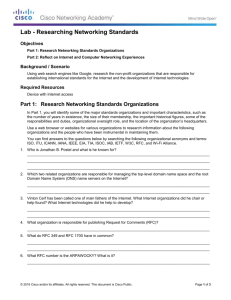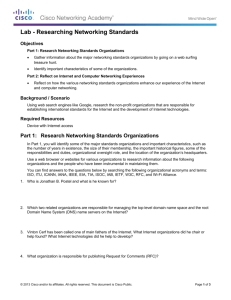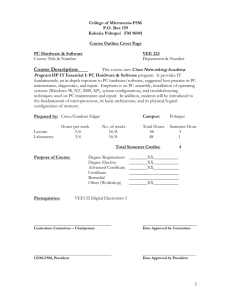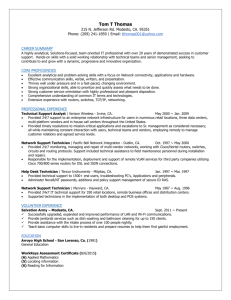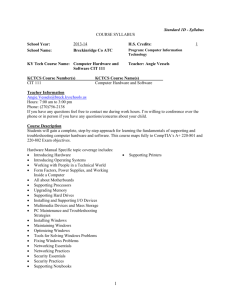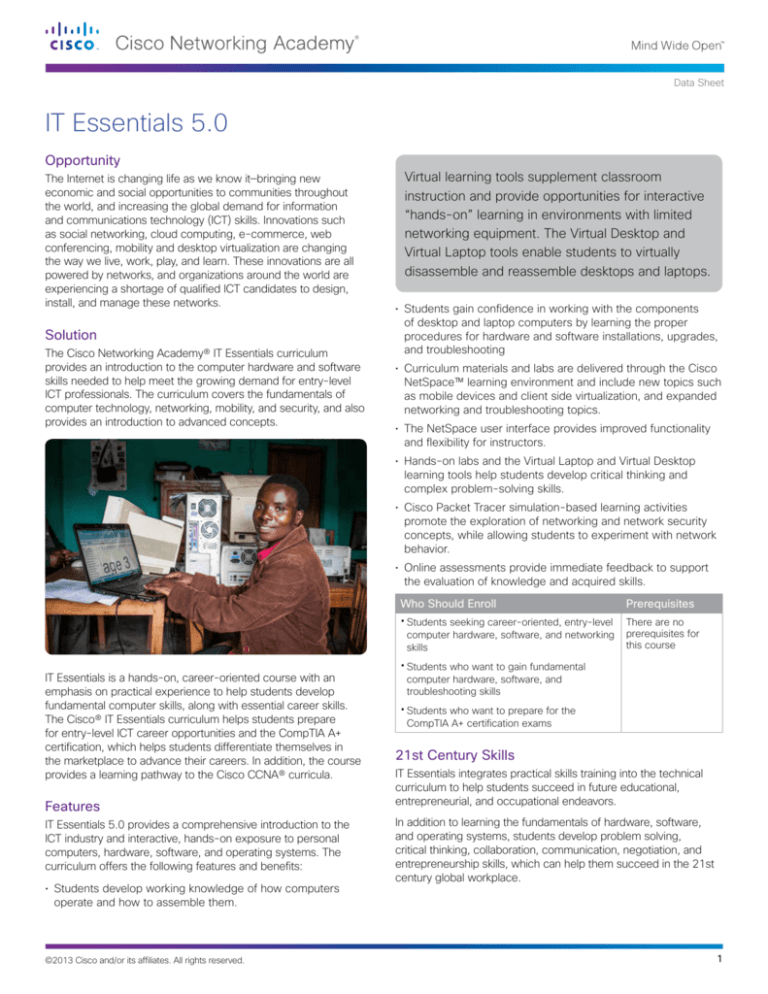
Data Sheet
IT Essentials 5.0
Opportunity
The Internet is changing life as we know it—bringing new
economic and social opportunities to communities throughout
the world, and increasing the global demand for information
and communications technology (ICT) skills. Innovations such
as social networking, cloud computing, e-commerce, web
conferencing, mobility and desktop virtualization are changing
the way we live, work, play, and learn. These innovations are all
powered by networks, and organizations around the world are
experiencing a shortage of qualified ICT candidates to design,
install, and manage these networks.
Solution
The Cisco Networking Academy® IT Essentials curriculum
provides an introduction to the computer hardware and software
skills needed to help meet the growing demand for entry-level
ICT professionals. The curriculum covers the fundamentals of
computer technology, networking, mobility, and security, and also
provides an introduction to advanced concepts.
Virtual learning tools supplement classroom
instruction and provide opportunities for interactive
“hands-on” learning in environments with limited
networking equipment. The Virtual Desktop and
Virtual Laptop tools enable students to virtually
disassemble and reassemble desktops and laptops.
• Students gain confidence in working with the components
of desktop and laptop computers by learning the proper
procedures for hardware and software installations, upgrades,
and troubleshooting
• Curriculum materials and labs are delivered through the Cisco
NetSpace™ learning environment and include new topics such
as mobile devices and client side virtualization, and expanded
networking and troubleshooting topics.
• The NetSpace user interface provides improved functionality
and flexibility for instructors.
• Hands-on labs and the Virtual Laptop and Virtual Desktop
learning tools help students develop critical thinking and
complex problem-solving skills.
• Cisco Packet Tracer simulation-based learning activities
promote the exploration of networking and network security
concepts, while allowing students to experiment with network
behavior.
• Online assessments provide immediate feedback to support
the evaluation of knowledge and acquired skills.
Who Should Enroll
•Students seeking career-oriented, entry-level
computer hardware, software, and networking
skills
IT Essentials is a hands-on, career-oriented course with an
emphasis on practical experience to help students develop
fundamental computer skills, along with essential career skills.
The Cisco® IT Essentials curriculum helps students prepare
for entry-level ICT career opportunities and the CompTIA A+
certification, which helps students differentiate themselves in
the marketplace to advance their careers. In addition, the course
provides a learning pathway to the Cisco CCNA® curricula.
Features
IT Essentials 5.0 provides a comprehensive introduction to the
ICT industry and interactive, hands-on exposure to personal
computers, hardware, software, and operating systems. The
curriculum offers the following features and benefits:
• Students develop working knowledge of how computers
operate and how to assemble them.
©2013 Cisco and/or its affiliates. All rights reserved.
Prerequisites
There are no
prerequisites for
this course
•Students who want to gain fundamental
computer hardware, software, and
troubleshooting skills
•Students who want to prepare for the
CompTIA A+ certification exams
21st Century Skills
IT Essentials integrates practical skills training into the technical
curriculum to help students succeed in future educational,
entrepreneurial, and occupational endeavors.
In addition to learning the fundamentals of hardware, software,
and operating systems, students develop problem solving,
critical thinking, collaboration, communication, negotiation, and
entrepreneurship skills, which can help them succeed in the 21st
century global workplace.
1
Data Sheet
Assessments
Course Description
Formative and summative assessments are integrated into the
IT Essentials curriculum and supported by an advanced online
delivery system. Immediate, rich feedback supports instructor and
student evaluation of acquired knowledge and skills. Assessments
can be as simple as a multiple choice question or as complex as
troubleshooting a simulated network.
The IT Essentials course covers the fundamentals of computer
hardware and software and advanced concepts such as security,
networking, and the responsibilities of an IT professional. It is
designed for students who want to pursue careers in ICT and
students who want to gain practical knowledge of how a computer
works.
Cisco Packet Tracer
Packet Tracer is a powerful network simulation program developed
by Cisco Networking Academy that allows students to experiment
with network behavior and ask “what if” questions. As an integral
part of the IT Essentials curriculum, Packet Tracer provides
simulation, visualization, authoring, assessment, and collaboration
capabilities and facilitates the process of teaching and learning
computer technology concepts.
Packet Tracer supplements physical equipment by allowing
students to create networks with an almost unlimited number
of devices; encouraging open learning, experimentation, and
troubleshooting. The simulation-based learning environment helps
students develop decision making, critical thinking, and problem
solving skills.
IT Essentials encourages students to explore
networking concepts using the Cisco Packet Tracer
simulation and learning tool. Packet Tracer allows
students to experiment with network behavior and
develop critical thinking, collaboration, and problem
solving skills, while gaining practical knowledge.
©2013 Cisco and/or its affiliates. All rights reserved.
Students who complete this course will be able to describe the
internal components of a computer, assemble a computer system,
install an operating system, and troubleshoot using system tools
and diagnostic software. Students will also be able to connect
to the Internet and share resources in a networked environment.
New topics in this version include mobile devices such as tablets
and smartphones and client side virtualization. Expanded topics
include security, networking, and troubleshooting.
Hands-on lab activities are essential elements that are integrated
into the curriculum. The Virtual Laptop and Virtual Desktop are
standalone tools that enable students to virtually disassemble
and reassemble desktop and laptop computers. Both tools are
designed to supplement classroom learning and provide an
interactive “hands-on” experience in environments with limited
networking equipment.
Packet Tracer activities are designed for use with Packet Tracer
5.3.x. The inclusion of Packet Tracer supports alignment with
the new CompTIA A+ certification objectives without requiring
academies to purchase extra networking equipment.
2
Data Sheet
Course Outline
Chapter
Goals
1. Introduction to the
Personal Computer
Describe a personal computer system
2. Lab Procedures and
Tool Use
Demonstrate safe lab procedures and
proper tool use
3. Computer Assembly
Demonstrate safe lab procedures and
proper tool use
4. Overview of Preventive
Maintenance and
Troubleshooting
Explain the purpose of and basic rules
of preventive maintenance and the
troubleshooting process
5. Operating Systems
Install, upgrade, navigate and
troubleshoot various operating systems
6. Networks
Describe, create and maintain a
network
7. Laptops
Describe how laptops are constructed,
their basic configuration, maintenance,
and troubleshooting
8. Mobile Devices
Describe operating systems, basic
configuration, maintenance, security
and repair for mobile devices
9. Printers
Demonstrate all procedures required
for printers
10. Security
Explain importance of security, describe
procedures, and perform security
measures
11. The IT Professional
Describe the communication and
related skills needed by an IT
professional
12. Advanced
Troubleshooting
Perform advanced troubleshooting
procedures on computers, operating
systems, laptops, printers, network and
security
Learning Outcomes
Upon completion of the IT Essentials course, students will be able
to perform the following tasks:
• Define information technology (IT) and describe the
components of a personal computer
• Describe how to protect people, equipment, and the
environment from accidents, damage, and contamination
• Perform a step-by-step assembly of a desktop computer
• Explain the purpose of preventive maintenance and identify the
elements of the troubleshooting process
• Install and navigate an operating system
• Configure computers to connect to a network
• Upgrade or replace components of a laptop based on
customer needs
• Describe the features and characteristics of mobile devices
• Install and share a printer
• Implement basic hardware and software security principles
©2013 Cisco and/or its affiliates. All rights reserved.
• Apply good communications skills and demonstrate
professional behavior while working with customers
• Perform preventive maintenance and basic troubleshooting
• Assess customer needs, analyze possible configurations, and
provide solutions or recommendations for hardware, operating
systems, networking, and security
Learning Environment
IT Essentials can be delivered as an independent curriculum or
integrated into a broader course of study, such as technology or
continuing education programs.
Industry Recognized Certification
As a CompTIA Authorized Quality Curriculum, IT Essentials helps
students prepare for the CompTIA A+ certification. The 801 exam
covers PC hardware, networking, laptops, printers, and operational
procedures. The 802 exam covers operating systems, security,
mobile devices, and troubleshooting. Students must pass both
exams to earn the CompTIA A+ certification.
Careers
The IT Essentials curriculum supports students who want to
prepare for entry-level positions in the ICT field within several
different types of working environments:
• A corporate or mobile environment with a high level of
face-to-face client interaction. Job titles include enterprise
technician, IT administrator, field service technician, and PC
technician.
• A remote work environment where client interaction, client
training, operating systems, and connectivity issues are
emphasized. Job titles include remote support technician, help
desk technician, call center technician, IT specialist, and IT
representative.
• Settings with limited customer interaction where hardwarerelated activities are emphasized. Job titles include depot
technician and bench technician.
3
Data Sheet
Translated and Accessible
We are committed to making our courses and documentation
accessible and usable by all students to help them achieve their
goals. Our translation strategy for IT Essentials is focused on the
following United Nations languages: Arabic, Simplified Chinese,
French, Russian, and Spanish.
IT Essentials is also compatible with screen readers for students
with accessibility needs—including those with visual and dexterity
limitations. Media text descriptions are provided for course content
and assessments.
Cisco Networking Academy
In partnership with schools and organizations around the
world, the Cisco Networking Academy program delivers a
comprehensive learning experience to help students develop ICT
skills for entry-level career opportunities, continuing education,
and globally recognized career certifications. The courses also
help students build 21st century skills such as collaboration and
problem solving by encouraging practical application of knowledge
through hands-on activities and network simulations.
Cisco Networking Academy teaches ICT skills to students from
virtually every socioeconomic background and region of the world.
Students gain the skills needed to pursue networking careers in
a variety of industries such as technology, healthcare, financial
services, fashion, and entertainment. Students also gain access
to a global support group, career developments tools, and social
networking resources.
For More Information
To learn more about Cisco Networking Academy, visit
www.netacad.com.
Cisco and the Cisco logo are trademarks or registered trademarks of Cisco and/or its
affiliates in the U.S. and other countries. To view a list of Cisco trademarks, go to this URL:
www.cisco.com/go/trademarks. Third-party trademarks mentioned are the property of their
respective owners. The use of the word partner does not imply a partnership relationship
between Cisco and any other company. (1110R)
C78-587889-01 01/13
©2013 Cisco and/or its affiliates. All rights reserved.
4




